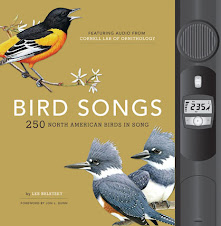We found one more warbler on our list from the bird barn!

Common Yellow Throat
It is a warbler so it eats insects. It lives in marshlands. It has a call like a rubberband going, "twang!"
Facts we learned while making this post:
We found a call, but it doesn't sound like "twang!" like it's supposed to. Maybe it is a different kind
of call because birds sure do have a lot of calls. Here's the one we found.
The male has a black mask that can be bigger or smaller, depending on the bird.
Some don't migrate. The ones that live in the north migrate at night. They spend the winter in Mexico and Central America.
Vireos
Vireos don't have a very pointed bill, and they don't eat just bugs. They also eat fruit. Their bills have a little hook on the end.
Philadelphia Vireo
It eats bugs, has a yellow belly, and a black stripe at the eyes.

Facts we learned while making this post:
First we heard the call.
A group of vireos is known as a "call of vireos."
It spends the winter in the tropics. In the summer, it spends time in the northern USA and Canada.
It likes to live in woodlands and old clearings.
If it will be found in Philadelphia, it will only be during migration.
Blue Headed Vireo
We took a picture of this bird, but we didn't take any notes. Here is our picture.

Facts we learned while making this post:
Here is the call.
It used to be called the solitary vireo. It lives in forest canopies. The canopy is the top. It migrates to the south for winter.




Hi Arden and Jill,
ReplyDeleteWe tried to leave a comment earlier, but it didn't work... now that we think we have it right, we'd like to say how cool this is! Lily and Will love the bird calls you include on your blog.. very neat to hear birds we never hear in Danville! They really like the woodpecker, and the Rose Breasted Grosbeak. Super fun for the kids to check out!
The software we developed at my office is named "Vireo" after this bird! It is less exciting than the actual bird.
ReplyDelete